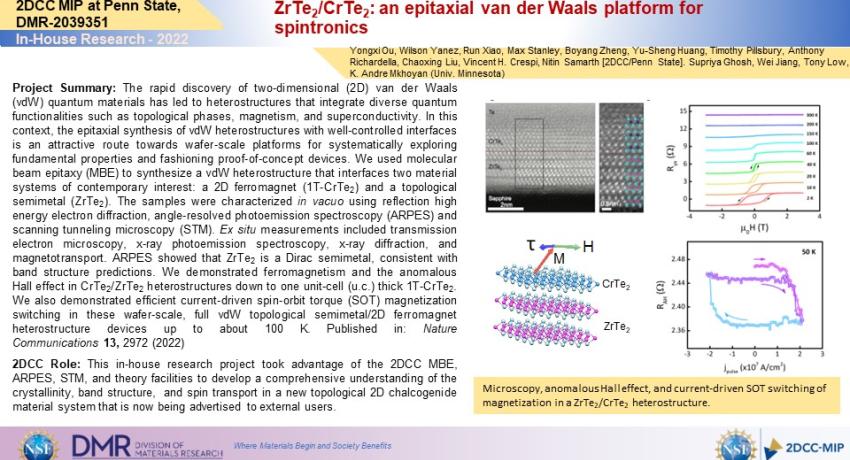Project Summary: The rapid discovery of two-dimensional (2D) van der Waals (vdW) quantum materials has led to heterostructures that integrate diverse quantum functionalities such as topological phases, magnetism, and superconductivity. In this context, the epitaxial synthesis of vdW heterostructures with well-controlled interfaces is an attractive route towards wafer-scale platforms for systematically exploring fundamental properties and fashioning proof-of-concept devices. We used molecular beam epitaxy (MBE) to synthesize a vdW heterostructure that interfaces two material systems of contemporary interest: a 2D ferromagnet (1T-CrTe2) and a topological semimetal (ZrTe2). The samples were characterized in vacuo using reflection high energy electron diffraction, angle-resolved photoemission spectroscopy (ARPES) and scanning tunneling microscopy (STM). Ex situ measurements included transmission electron microscopy, x-ray photoemission spectroscopy, x-ray diffraction, and magnetotransport. ARPES showed that ZrTe2 is a Dirac semimetal, consistent with band structure predictions. We demonstrated ferromagnetism and the anomalous Hall effect in CrTe2/ZrTe2 heterostructures down to one unit-cell (u.c.) thick 1T-CrTe2. We also demonstrated efficient current-driven spin-orbit torque (SOT) magnetization switching in these wafer-scale, full vdW topological semimetal/2D ferromagnet heterostructure devices up to about 100 K. Published in: Nature Communications 13, 2972 (2022)
2DCC Role: This in-house research project took advantage of the 2DCC MBE, ARPES, STM, and theory facilities to develop a comprehensive understanding of the crystallinity, band structure, and spin transport in a new topological 2D chalcogenide material system that is now being advertised to external users.
What Has Been Achieved: We demonstrated MBE growth of a new hybrid vdW topological semimetal/2D ferromagnet quantum material by interfacing a 2D ferromagnet (1T-CrTe2) epitaxially with a Dirac semimetal (ZrTe2). We demonstrated efficient current-driven magnetization switching in these heterostructures. Importance of the Achievement: This work is an important step toward developing wafer scale topological 2D vdW quantum materials as an energy efficient platform for non-volatile random access memory.
Unique Feature(s) of the MIP that Enabled this Achievement: the 2DCC MBE/ARPES/STM and theory facilities were essential for obtaining a comprehensive understanding of this new family of heterostructures.
(If Applicable) Publication:
Yongxi Ou, Wilson Yanez, Run Xiao, Max Stanley, Supriya Ghosh, Boyang Zheng, Wei Jiang, Yu-Sheng Huang, Timothy Pillsbury, Anthony Richardella, Chaoxing Liu, Tony Low, Vincent H. Crespi, K. Andre Mkhoyan, Nitin Samarth.
, ZrTe2/CrTe2: an epitaxial van der Waals platform for spintronics. Nat Commun 13, 2972 (2022). https://doi.org/10.1038/s41467-022-30738-1
Acknowledgements: The MBE synthesis, ARPES, STM measurements and theoretical calculations were supported by the Penn State Two-Dimensional Crystal Consortium-Materials Innovation Platform (2DCC-MIP) under NSF Grant No. DMR-2039351 (YO, BZ, MS, TP, AR, VHC, NS). Transport measurements were carried out under support of the Institute for Quantum Matter under DOE EFRC grant DE-SC0019331 (RX, NS). The TEM, XRD, and SOT measurements were supported by SMART, one of seven centers of nCORE, a Semiconductor Research Corporation program, sponsored by the National Institute of Standards and Technology (NIST) (WY, YSH, SG, TL, KAM, NS). Parts of this work were carried out in the Characterization Facility, University of Minnesota, which receives partial support from the NSF through the MRSEC (Award Number DMR-2011401) and the NNCI (Award Number ECCS-2025124) programs (SG, KAM).
